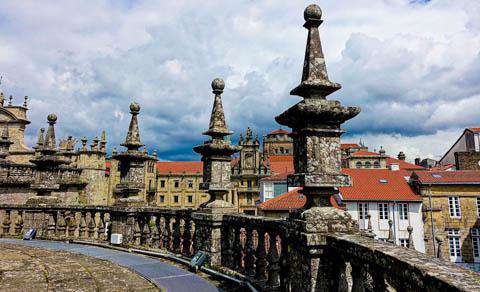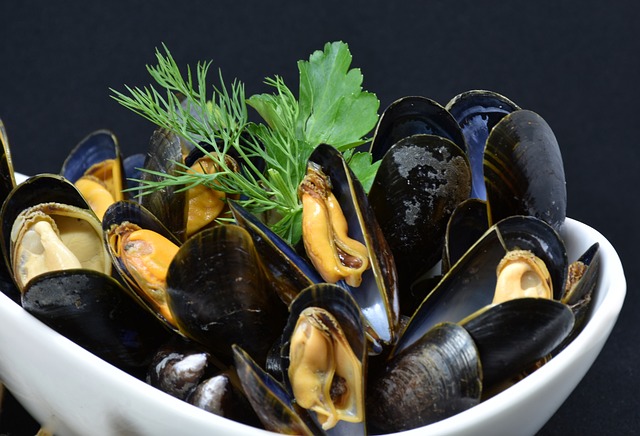It's easy to see why people visit Santiago de Compostela, given its museums and attractions, historical sights, hiking, and food.
The Cathedral de Santiago de Compostela is, of course, the centerpiece of the city. Its baroque facade sculpted in Galician granite dates back to the 12th century and is laid out on a basilica plan. The towers of the cathedral exist just as grand with an interior decked with elaborate archways and columns to match. Each piece of art sculpted into the design of the cathedral tells a story, biblical tributes, that have drawn pilgrims to the site for centuries.
The square in front of the cathedral, called the Praza do Obradoiro, is surrounded by more architectural gems. Though the cathedral is outstanding by far, there are other historic structures significant to the city, like the Pazo de Xelmirez with its vaulted medieval interior, the Hostal dos Reis Catolicos built by Ferdinand and Isabella, the medieval Colexio de San Xerome, and the Renaissance college Colexio de Fonseca. The surrounding area also has beautiful courtyards, and a famous ornate fountain of four horses with webbed feet called the Fuente de los Caballos.
Beyond the endless opportunities for wandering old town streets and taking in grandiose architectural wonders, the city has a history that cannot be better told than by visiting some of the local museums. The Cathedral Museum, for example, shows the main Cathedral's history and artistic testimonies, from the first basilicas and archaeological remains to the present. Museum of the Galician People, housed in the former Convent of Santo Domingo de Bonaval, displays different aspects of costal life, traditional trades, the country, traditional costumes, and architecture. The Pilgrimage Museum also exhibits important history highlighting the significance, for European culture and Hispanic America, of the pilgrimage and worship of St. James. And as far as the art culture goes, Galician Centre of Contemporary Art has been holding a stable program in Old Town since 1995.
The city also is home to various monasteries, being deeply rooted in religion. The outlying Santa Maria de Conxo Monastery is one such example important to Santiago de Compostela history.
Other activities include guided tours, shopping, and dining.
Museums and Attractions:
 Museums and landmarks are a major reason why Santiago de Compostela attracts so many visitors. The iconic Cathedral of Santiago has long attracted pilgrims and travelers from around Europe and the world. The spectacular sight includes a museum and the crypt and tomb of Saint James. Another interesting sight in town is the former hostel for pilgrims, the Hostal de los Reyes Católicos. Also make sure you visit Plaza del Obradoiro and the Galician Center of Contemporary Art.
Museums and landmarks are a major reason why Santiago de Compostela attracts so many visitors. The iconic Cathedral of Santiago has long attracted pilgrims and travelers from around Europe and the world. The spectacular sight includes a museum and the crypt and tomb of Saint James. Another interesting sight in town is the former hostel for pilgrims, the Hostal de los Reyes Católicos. Also make sure you visit Plaza del Obradoiro and the Galician Center of Contemporary Art.
Historical Sights:
 Many people come to experience the charm of the historic old town. The old town reflects the city's importance in the Christian religion. There are Romanesque, Gothic and Baroque buildings that draw Christian pilgrims from around the world.
Many people come to experience the charm of the historic old town. The old town reflects the city's importance in the Christian religion. There are Romanesque, Gothic and Baroque buildings that draw Christian pilgrims from around the world.
Hiking:
 Hiking in and around Santiago de Compostela is absolutely fantastic. This small city is the culmination point for the famed Camino de Santiago. The 780 kilometer route is followed by pilgrims and travelers who seek enlightenment or adventure. Hikers travel both independently or as part of organized tours.
Hiking in and around Santiago de Compostela is absolutely fantastic. This small city is the culmination point for the famed Camino de Santiago. The 780 kilometer route is followed by pilgrims and travelers who seek enlightenment or adventure. Hikers travel both independently or as part of organized tours.
Shopping:
The shopping experience here is something you have to do. There are local markets, souvenir shops, and boutiques where you can buy items to commemorate the completion of your hike or your visit to town.
Local tours that last a few hours can be a great way to explore Santiago de Compostela. Prices vary by the type of activity or tour, the dates, and the size of the group. Here are a few of the highest rated tours by previous visitors:
- Secrets of Compostela Private Tour for $54 details
- Tapas Tour with Drinks and Tapas included at Old Town of Santiago for $34 details
- Santiago de Compostela Scavenger Hunt and Sights Self-Guided Tour for $9 details
 The Cathendral of Santiago de Compostela, Spain
The Cathendral of Santiago de Compostela, Spain


 Museums and landmarks are a major reason why Santiago de Compostela attracts so many visitors. The iconic Cathedral of Santiago has long attracted pilgrims and travelers from around Europe and the world. The spectacular sight includes a museum and the crypt and tomb of Saint James. Another interesting sight in town is the former hostel for pilgrims, the Hostal de los Reyes Católicos. Also make sure you visit Plaza del Obradoiro and the Galician Center of Contemporary Art.
Museums and landmarks are a major reason why Santiago de Compostela attracts so many visitors. The iconic Cathedral of Santiago has long attracted pilgrims and travelers from around Europe and the world. The spectacular sight includes a museum and the crypt and tomb of Saint James. Another interesting sight in town is the former hostel for pilgrims, the Hostal de los Reyes Católicos. Also make sure you visit Plaza del Obradoiro and the Galician Center of Contemporary Art. Many people come to experience the charm of the historic old town. The old town reflects the city's importance in the Christian religion. There are Romanesque, Gothic and Baroque buildings that draw Christian pilgrims from around the world.
Many people come to experience the charm of the historic old town. The old town reflects the city's importance in the Christian religion. There are Romanesque, Gothic and Baroque buildings that draw Christian pilgrims from around the world. Hiking in and around Santiago de Compostela is absolutely fantastic. This small city is the culmination point for the famed Camino de Santiago. The 780 kilometer route is followed by pilgrims and travelers who seek enlightenment or adventure. Hikers travel both independently or as part of organized tours.
Hiking in and around Santiago de Compostela is absolutely fantastic. This small city is the culmination point for the famed Camino de Santiago. The 780 kilometer route is followed by pilgrims and travelers who seek enlightenment or adventure. Hikers travel both independently or as part of organized tours.
 Budget Your Trip is all about finding out how much everything costs so that you can travel cheaper and longer. Created by avid travelers Laurie and Bryan, our goal is to help you plan your next trip on the right budget. With average daily travel costs that are calculated from the budgets of real travelers, plus an analysis of hotel and tour prices, you can find out how much money you need to plan your next adventure. We also have plenty of travel advice, accommodation reviews, and activity suggestions.
Budget Your Trip is all about finding out how much everything costs so that you can travel cheaper and longer. Created by avid travelers Laurie and Bryan, our goal is to help you plan your next trip on the right budget. With average daily travel costs that are calculated from the budgets of real travelers, plus an analysis of hotel and tour prices, you can find out how much money you need to plan your next adventure. We also have plenty of travel advice, accommodation reviews, and activity suggestions.